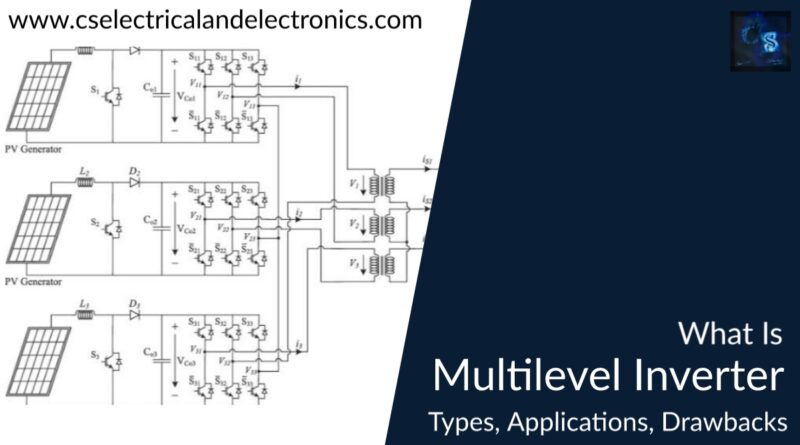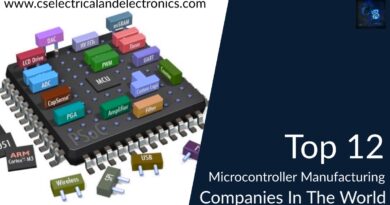What Is Multilevel Inverter, Types, Applications Of Multilevel, Drawbacks
Hello guys, welcome back to our blog. In this article, we will discuss what is multilevel inverter, the types of multilevel inverters, their applications, features, their importance of it, drawbacks, etc.
If you have any electrical, electronics, and computer science doubts, then ask questions. You can also catch me on Instagram – CS Electrical & Electronics.
Also, read:
- Power Electronics Projects For Engineers, Diploma And MTech Students.
- Digital Electronics Interview Questions And Answer Most Commonly Asked.
- Top 10 Apps For Electrical And Electronics Engineers, Apps For Engineers.
What Is Multilevel Inverter
Nowadays multi-level inverters have drawn tremendous interest in the power industry. The general configuration is to synthesize a sinusoidal voltage from several levels of bold areas obtained from the capacitor voltage source. These Inverters not only achieve high power ratings but also enable the use of renewable energy sources such as photovoltaic, wind, and fuel cells.
The application of ac variable frequency speed regulations are widely popularized high power and medium voltage inverter has recently become a research focus so far as known there are many problems in conventional two-level inverter in the high power application.
The multilevel inverter has gained more attention for high-power applications. In recent years it can operate at high switching frequencies while producing lower order harmonic components. As the number of levels increases, the waveform approaches sinusoidal and with minimum harmonic distortion. As the number of levels increases, voltage levels increases.
Features Of Multilevel Inverter
- A low rate of change in voltage and very low distortion have been generated.
- It naturally rectifies the large voltage transients.
- They can generate a very low distorted input current and can be operated with a very low switching frequency.
Types Of Multi-level Inverters
There are 3 basic types of multi-level inverters. They are,
- Diode clamp multi-level inverter
- Flying capacitor multi-level inverter
- Cascaded multi-level inverter
01. Diode clamp multi-level inverter
A Diode lamp multi-level inverter consists of m-1 capacitors on the DC bus and producers m levels of the phase voltage. The Peak blocking voltage of the switch will be limited to one capacitor voltage level through clamping diodes. The switching time of different switches is different which depends on the duty cycle and time.
02. Flying capacitor multi-level inverter
It is the same as a diode clamp multi-level inverter. The phase voltage of an m level has m-1 capacitors with 2m-1 steps in the line voltage. A proper selection of switch combinations may be used in real power conversion. The basic problem in the selection of switch combination and frequency operation is higher than the fundamental frequency. With the increased number of voltage levels harmonic content reduces. The load cannot be directly connected to the neutral of the converter to generate the zero voltage level.
03. Cascaded multi-level inverter
For three-phase cascaded, three voltages are connected in a star or delta. It consists of a separate DC source and this is manipulated for various renewable energy sources like photovoltaic, fuel, biomass, etc. Soft switching can be possible to avoid bulky resistor-capacitor combinations.
Today more and more commercial products are based on multi-level inverters and more technical research is running on multi-level inverters.
Applications of Multi-level inverter
- Energy and power systems.
- Regenerative conveyors in production.
- Transportation.
Multi-level inverters have updated from being an emerging technology to a well-established and attractive solution for medium voltage high power applications.
The continuous development of technology and the evolution of industrial applications will open new challenges and opportunities that could further motivate improvements in multi-level inverters.
Multi-level inverter fault tolerance operation
There is a growing rate of interest in the industry to reduce stop times and increase availability through system monitoring, fault detection, and fault tolerance operation. In this way, we can increase productivity, reduce costs, and also can implement safety improvements. In these types of converters or inverters, the failure can be due to DC short circuit to the ground, a capacitor bank short circuit, or damage to switches. All these kinds of failures are due to power semiconductors.
Multi-level converter modulation methods
There is the inherent additional complexity of having more powerful electronic devices to control. As a consequence, a large number of different modulation algorithms are adopted. These algorithms are classified depending on the average switching frequency with which they operate. For high-power applications, the maximum switching frequency is up to 1KHz.
- Phase shift pulse width modulation inverters.
- Level-shifted pulse width modulation inverters.
- Hybrid pulse width modulation inverters.
- Space vector modulation algorithm
Importance of Multi-level Inverters
- These inverters are used in every field. It has become quite famous in medium and higher applications.
- It has less disturbance when compared to the conventional inverter. Voltage stress across switches is also been reduced.
- They can synthesize switched waveforms with low order distortion.
Drawbacks
- It has a complex structure.
- It utilizes more input sources.
This was about “What Is Multilevel Inverter“. I hope this article may help you all a lot. Thank you for reading.
Also, read:
- 10 Tips To Maintain Battery For Long Life, Battery Maintainance
- 10 Tips To Save Electricity Bills, Save Money By Saving Electricity
- 100 (AI) Artificial Intelligence Applications In The Automotive Industry
- 100 + Electrical Engineering Projects For Students, Engineers
- 1000+ Control System Quiz, Top MCQ On Control System
- 1000+ Electrical Machines Quiz, Top MCQs On Electrical Machines
- 1000+ Electronics Projects For Engineers, Diploma, MTech Students
- 1000+ MATLAB Simulink Projects For MTech, Engineering Students
Author Profile
- Content Writer








